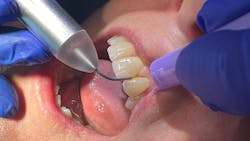How dental hygienists can encourage greater use of lasers in the dental office
When we have patients in the dental chair, we have the chance to do much more than merely clean their teeth. We can protect against infection and have a front row seat in our patients’ oral health. Dental practices also have the unique opportunity to utilize the latest and greatest in dental technology. Among these is the implementation of lasers. Dental hygienists are in a good position to spot occasions when a laser could be used for a particular procedure. Here are some dental procedures that doctors can perform with a dental laser, so keep an eye out for them as you treat your patients.
Read more about lasers in this series …
- So, you want to be a laser dental hygienist?
- Which dental laser should I choose, and what can I use it for?
- What type of training do dental hygienists need to use lasers?
- What is the difference between LAPT and LBR?
- Laser safety eyewear: It’s nonnegotiable
- How do you find the best laser for your dental practice?
- Laser procedures for dental hygienists: Herpetic lesions and desensitization
- Physics and the dental laser
Hemostasis
Because many procedures we do can cause tissue trauma, and because various areas require special attention to control bleeding, hemostasis is an example of an ideal procedure for the use of lasers. After tooth extractions, diode lasers can be used to help control the bleeding. They do so by creating a blood clot, which begins the healing process.
Gingivectomy
When patients have copious amounts of bulbous tissue that require more involved cleaning, it is a prime opportunity to use a laser to trim back the tissue. This can be beneficial not only when patients have gingival hyperplasia, but also because of the laser’s properties of minimizing gum tissue.
Mucocele
A mucocele is a lump underneath the tissue that impinges on appearance and has the potential to interfere with speaking. Lasers can assist in opening up the tissue to allow the dentist to find the mucocele lurking underneath, and subsequently remove all areas of concern.
Fibroma removal
If there are nodules on the inside of the patient’s cheek or on the patient’s tongue, a laser can be used to remove them. Removing fibroma nodules with a laser creates hemostasis, which improves the patient’s healing response.
Frenectomy
Upon discovery, a frenum should be removed for various reasons. Whether a lingual frenum of a patient who is tongue-tied, a labial frenum on upper centrals for future orthodontics, or for recessive areas that pull on the tissue, lasers can easily release excess tissue.
Tissue recontouring
Many times, clinicians see uneven levels of tissue around teeth. This can affect the appearance of the patient’s smile. A laser can be used to recontour and even out this tissue. This makes the tissue more balanced and creates a better smile that patients will love to share.
Gingival troughing
Using a laser in a bloodless site allows the clinician to trough the gingival tissue, thus creating exceptionally clean margins. Gingival troughing is the number one reason why dental practices buy lasers.
Hard tissue dental lasering
If your dentist has a hard tissue dental laser, look for procedures that it can be used for, such as preparation of tooth structure and bone recontouring.
Look for opportunities to use lasers
These are only some of the applications for lasers in dentistry. Watch for these situations as they arise during your time with patients. This mindfulness not only helps us in our hygiene chairs, but also provides further opportunities for patients to experience the laser.
Every day, we have opportunities to discuss laser applications with our patients. Our first step as hygienists is taking the time to seek them out.
Author’s note: The Academy of Laser Dentistry is a good resource.
Editor’s note: This article first appeared in Through the Loupes newsletter, a publication of the Endeavor Business Media Dental Group. Read more articles and subscribe to Through the Loupes.
About the Author
Angie Wallace, RDH
Angie Wallace, RDH, has been a clinical hygienist for more than 35 years. She is a member of the Academy of Laser Dentistry (ALD), where she obtained her advanced level proficiency, educator status, Recognized Course Provider status, and mastership. Angie is the chair for education on the ALD Board of Directors and serves on both the Regulatory Affairs and Auxiliary committees. She has a laser education consulting company, Laser Hygiene, LLC, and has been recognized as a worldwide speaker. Contact her at [email protected].

